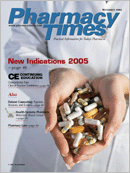Publication
Article
Web Site Provides Drug Info on Hurricane Survivors
The seed for www.KatrinaHealth.org was planted with a phone call on Labor Day weekend. David Brailer, MD, PhD, national coordinator for health information technology, called Kevin Hutchinson, president and chief executive officer of SureScripts, about developing an on-line service for health professionals to gain electronic access to prescription medication records for Hurricane Katrina survivors. The Web site was officially launched on September 22, 2005.
"Many of the hurricane evacuees were displaced," said Hutchinson. "They lost their medications, and some did not know what medications they took. We needed to help the physicians and pharmacists replenish [their patients'] medications." SureScripts was a "natural fit, given the relationship we have with pharmacies," he continued. His company is the provider of the SureScripts Electronic Prescribing Network, a health care infrastructure, which establishes electronic communication between pharmacists and physicians and enables the 2-way electronic exchange of prescription information.
The next step was getting a database of 90 days' worth of prescription drug information from the affected areas. "We were able to get all the affected pharmacies together in one conference call, and not a single pharmacy hesitated a moment about helping us. They said, 'tell us what you need,'" added Hutchinson.
SureScripts was only 1 of 3 major sources of the prescription data necessary to launch the site. Gold Standard, a developer of drug information databases, software, and clinical information systems, provided Medicaid information. "We had Medicaid in Mississippi as a customer before and after the hurricane hit. We also had a relationship with Medicaid in Louisiana," said David Medvedeff, president of Informed Decisions, a subsidiary of Gold Standard.
"We entered the picture on 2 levels," Medvedeff continued. "Last year we had 4 hurricanes in Florida, and we had a real working knowledge of how to respond with health care IT. We were the only organization involved that had a front end," meaning that the company already had an access portal available for its Medicaid customers. Also, the Veterans Administration provided Gold Standard with medication histories for people in the 150 zip codes in the affected areas.
RxHub connected to Gold Standard to provide pharmacy benefit manager (PBM) medication histories. The company electronically routes up-to-date patient-specific medication history and pharmacy benefit information to caregivers at every point of care.
"It was rewarding to be able to work with our PBM/payer partners to provide medication histories to physicians at the point of care when trying to reconstruct medical records that had been destroyed by this natural disaster" , commented Rochelle Woolley, senior vice president and communication officer for RxHub.
Authorized clinicians and pharmacists using KatrinaHealth.org can view patients' prescription histories on-line, review available patient allergy information, view drug interaction reports and alerts, see therapeutic duplication reports, and query clinical pharmacology drug information. To guarantee that only authorized health care professionals use the Web site, the American Medical Association will provide physician credentialing and authentication services. The National Community Pharmacists Association will authenticate and provide access for independent pharmacies. SureScripts will provide these services for chain pharmacies on behalf of the National Association of Chain Drug Stores.
Both Hutchinson and Medvedeff said that they have gotten "tremendous feedback" from health care professionals using the site. As of press time, Hutchinson said that more pharmacists than physicians were using KatrinaHealth.org, because more patients were going to pharmacies to discuss their medication and get refills. No time frame has been established as to how long the site will be accessible.







